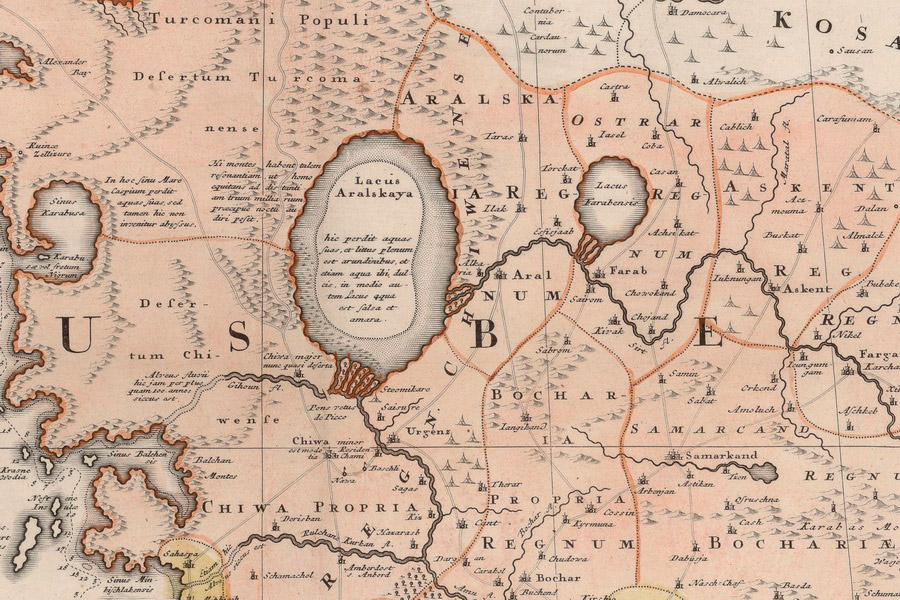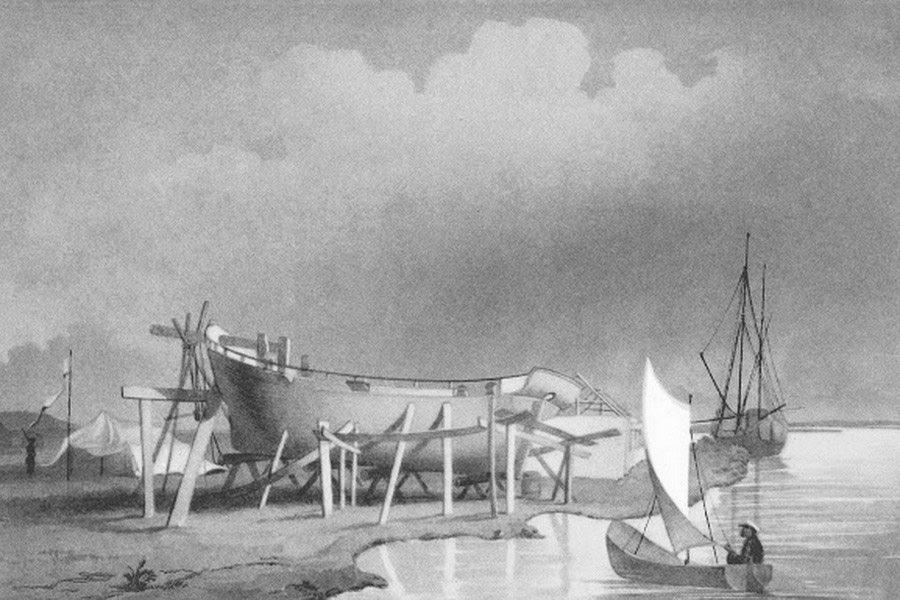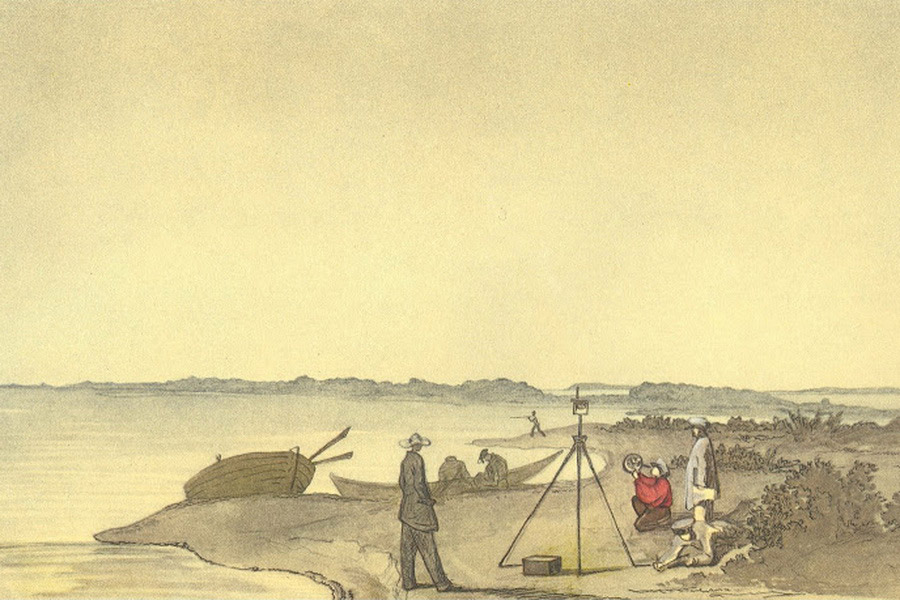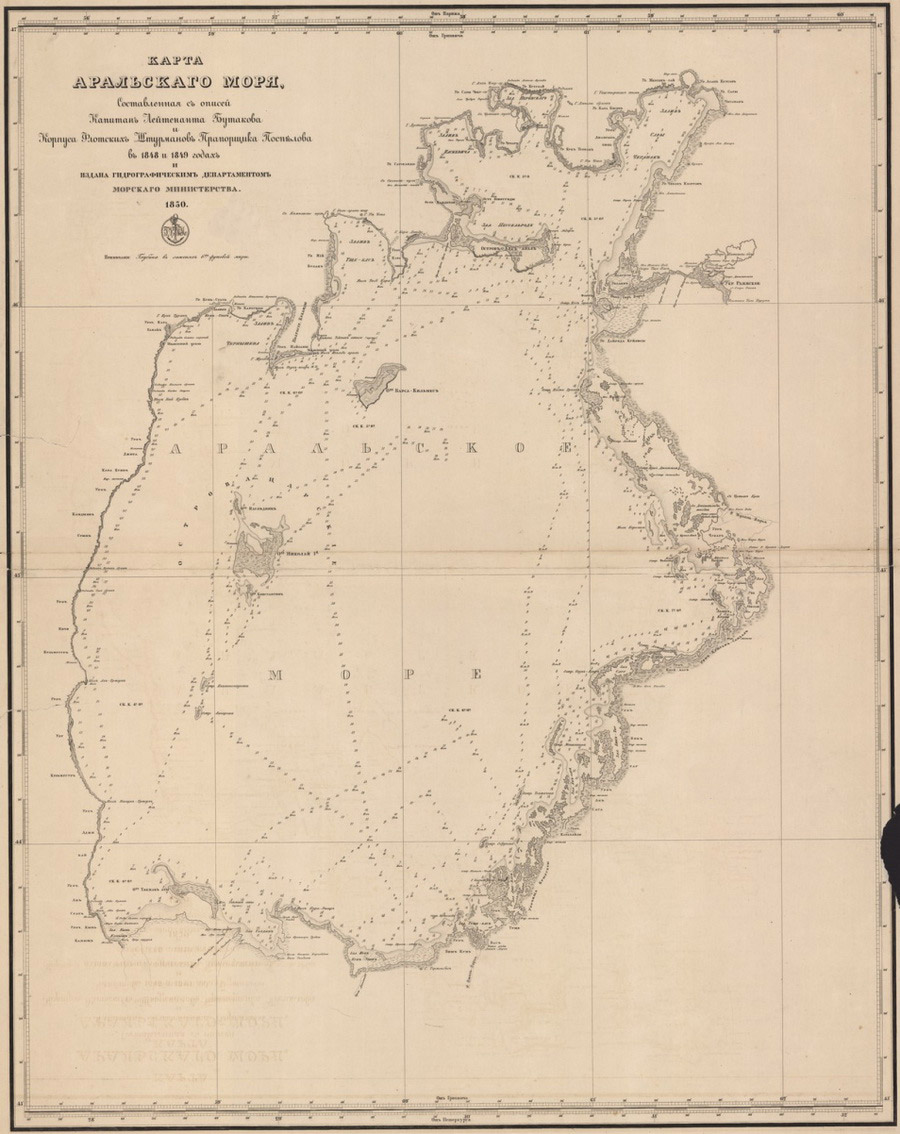 The Aral Sea on a map of 1735
The Aral Sea on a map of 1735
It's astonishing, but according to scientists' calculations, the Aral Sea is only 17,600 years old—a blink of an eye in geological terms. It seems that as the last Ice Age ended, glaciers from the Tian Shan and Pamir mountains began to melt, sending streams of water down the Syr Darya and Amu Darya rivers. It took over 2,000 years to fill the basin that would become the Aral Sea, and even then, the lake hadn't reached its full extent. The Amu Darya periodically changed its course, sometimes directing water to the Aral and sometimes to the Caspian Sea.
The Aral Sea's water level has fluctuated even in the last thousand years. In the 15th century, it was a group of large lakes, and by the end of the 16th century, the Aral Sea reached its maximum size. However, by the 17th century, the water level dropped, creating islands such as Barsa-Kelmes, Vozrozhdeniya, Kokaral, and others.
The human history of the Aral Sea begins in the 4th to 3rd millennia BCE. In those ancient times, Neolithic tribes settled along the shores of the Aral Sea and in the Amu Darya delta. They engaged in fishing and hunting, lived in large communal houses that could house up to 100 people, known to anthropologists as the Kelteminar culture.
 Aral Sea and Ustyurt Plateau, drawing by T. Shevchenko, 1849
Aral Sea and Ustyurt Plateau, drawing by T. Shevchenko, 1849
Over time, these people developed agriculture and irrigation. By the 7th century BCE, the state of Khorezm, which had risen on the banks of the Amu Darya south of the Aral Sea, was mentioned in historical records. In the northern part of the Aral Sea, there were no permanent settlements yet, and it was inhabited by nomadic tribes who occasionally raided Khorezm, which built fortresses for defense.
By the 1st century AD, the Aral Sea was known in the Roman Empire as the Oxian Lake, named after the river Oxus (Amu Darya). By the 10th century, the Arabs, having conquered Central Asia, called it the Khorezm Sea. It was also referred to as the Gurganj Sea and Syr.
In 2001, near the former island of Barsa-Kelmes in the northern part of the Aral Sea, the Kerderi mausoleum was discovered, followed by another mausoleum and a town named Aral-Asar. The Kerderi mausoleum, dating back to the 12th century, features burials associated with Islamic culture with elements of shamanism and Tengrism. The most recent burials were conducted in the 14th century. For centuries, the mausoleum and other archaeological finds were hidden under water, at a depth of 20 meters. Today, they are situated in Kazakhstan.
 Schooners Konstantin and Mikhail on the Aral Sea, drawing by T. Shevchenko, 1849
Schooners Konstantin and Mikhail on the Aral Sea, drawing by T. Shevchenko, 1849
Also, in the 12th-13th centuries, the Kurgancha-Kala fortress was built on the western coast of the Aral Sea, on the ledges of the Ustyurt Plateau. It is believed to have been the northernmost outpost of Khorezm and also served as a caravanserai where traders on the Great Silk Road stopped. Today, this fortress can be visited on a tour of the Aral Sea.
The name Aral Sea appeared in the late 17th century. In Turkic, it was called Aral-Tengiz, meaning "sea of islands" or "island sea": aral – "island", tengiz – "sea". This is thought to relate to the many islands that were in the Amu Darya delta at that time.
 Expedition on the shores of the Aral Sea, drawing by T. Shevchenko, 1849
Expedition on the shores of the Aral Sea, drawing by T. Shevchenko, 1849
In 1717, the Russian army led by Prince Alexander Bekovich-Cherkassky traveled to Khiva through the Ustyurt Plateau and along the Aral Sea. In 1847, the Raim fort was built in the northeastern part of the Aral, and today its ruins are in Kazakhstan. In 1849, the Russians conducted the first scientific expedition on the Aral Sea. For this, the schooner "Konstantin" was brought in parts to the northern shore of the Aral Sea. The expedition was led by A. Butakov, with the artist T. Shevchenko, a renowned Ukrainian writer and poet. They mapped the shoreline, measured depths, conducted meteorological and astronomical observations, and other scientific work. In 1850, a map of the Aral Sea was published in Russia.
 Map of the Aral Sea 1850
Map of the Aral Sea 1850
In 1852, the steamships "Perovsky" and "Obruchev" were brought in parts on camels to Fort Raim. In 1853, they were assembled and launched. They were tasked with patrolling the coastline of the Aral Sea and upstream along the Syr Darya. Other steamships were brought in, and trading and fishing vessels were built locally. Scientific expeditions were conducted, and trade routes were established. In 1905, Russian merchants created the "Khiva" joint-stock company in the city of Aralsk (Kazakhstan) and launched industrial-scale fishing.
 Steamship Obruchev before departure to the Aral Sea
Steamship Obruchev before departure to the Aral Sea
In the Soviet era, all fishing collectives were nationalized, and fish catch volumes grew annually. Fishermen caught species such as Aral salmon, bream, roach, carp, ruff, pike-perch, and others. In the best years, 50,000 tons of fish were caught in the Aral Sea. In the 1950s, the settlement of Muynak became the center of fishing in the southern part of the Aral Sea, and in 1963 it was granted city status.
The exact date of the beginning of the ecological disaster at the Aral Sea is unknown, but the first significant drop in water level was recorded in 1961. This was primarily linked to the increasing water needs of agriculture, as well as the construction of the Karakum Canal on the Amu Darya – the first part of the canal was opened in 1959. In 1962, when the canal was completed, it diverted 45% of all water from the Amu Darya.
In 1960, the water level of the Aral Sea was at 53.4 meters with an area of 68,900 square kilometers. By 1980, the water level had dropped to 46.4 meters, shrinking the sea's area to 51,700 square kilometers. In 1990, the water stood at 38.2 meters and the area further decreased to 36,800 square kilometers. By 2024, although exact data isn't available, the water level is roughly estimated at 28 meters with the sea covering just 7,000 square kilometers. The water level has fallen by 26 meters, and the sea's area has diminished tenfold!
 Ship cemetery in Muynak
Ship cemetery in Muynak
By the late 1980s, the fisheries in Muynak and Aralsk had shut down, and ships were permanently docked. Today, you can see the remains of these boats at the ship graveyard in Muynak.
From 2003 to 2005, the Kokaral Dam was constructed in Kazakhstan. This 13-kilometer dam was built to preserve the northern part of the Aral Sea, now known as the Small Aral. This project managed to restore the water level to 42 meters. Over time, the salinity of the water decreased, allowing fish to return and the ecosystem to begin recovering.
 View of the Aral Sea from an airplane, left and center - the former bottom, 2023
View of the Aral Sea from an airplane, left and center - the former bottom, 2023
In 2008, gas deposits were discovered on the dried-up seabed of the Aral Sea in Uzbekistan, where active gas extraction is currently ongoing. This area has transformed into the Aralkum Desert, developing its own ecosystem. Efforts are being made to enhance this new ecosystem by planting saxaul and other desert-adapted plant species.
It's possible that the Aral Sea will one day be replenished, but sadly, this is unlikely to happen within our century.

